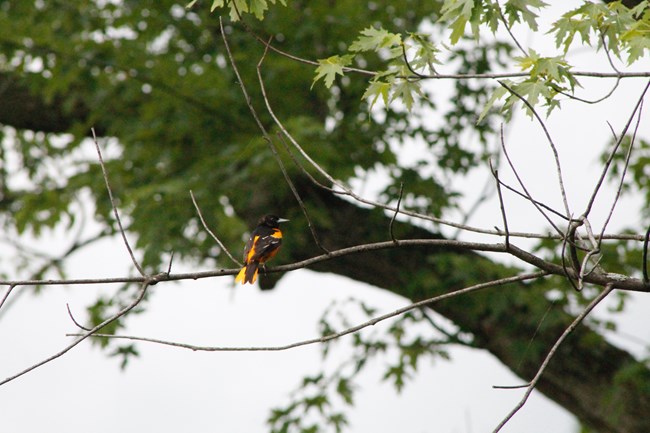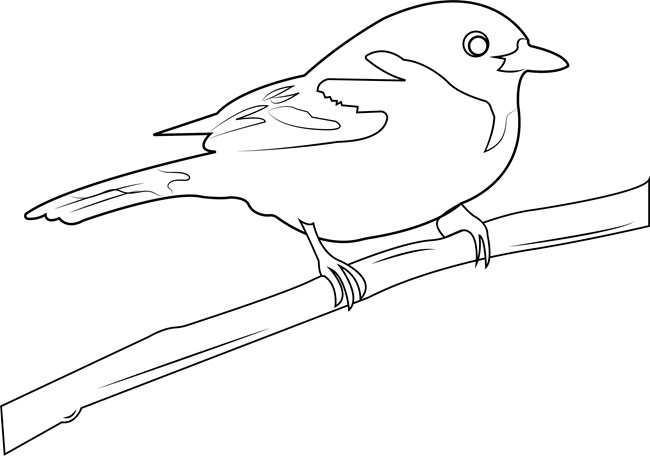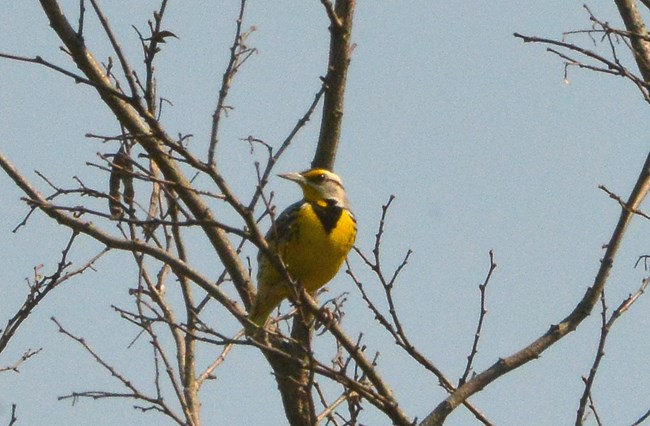|
NPS.gov / Park Home / Learn About the Park / Nature / Animals / Birds / Perching Birds
Icterids or blackbirds are a family of small- to medium-sized, often colorful birds. Most of the species in this family are mainly black in color but usually have colorful spots of yellow, orange, or red. The species in this family and very different in size, shape, behavor, and color.

NPS Photo/K. Simmons Baltimore Oriole (Icterus galbula)• You usually hear a Baltimore Oriole before you see them because they feed high in the trees. Listen closely for their wink or chatter calls.• They really enjoy searching leaves and branches for insects, flowers, and fruit • Baltimore Orioles can be found in open woodlands, forest edges, river banks, and small groves of trees 
NPS/Intern Tristan Thomas Identification Information:• Size: Robin sized (Small)• Color: Adult males are bright orange and black with a black head and one white bar on their black wings. Females are yellow/orange on their belly with two white bars on their wings 
© Bill Telfair Eastern Meadowlark (Sturnella magna)• Eastern Meadowlarks love to eat insects like crickets, grasshoppers, caterpillars, and grubs. In the winter they also like to eat weed seeds, spilled corn, and wild fruits.• They like to nest on the ground in grassland areas. To find a nest, females look for a small depression sometimes even a hoof print that is concealed by thick vegetation. Once they find a good spot females weave dead grass, plant stems, and strips of bark to make a nest. • When nesting, people should be very cautious to approach meadowlarks. If approached during the nesting period, females will abandon incubation of her eggs if she is forced off her nest. • The Eastern Meadowlark is not in the lark family they are a member of the blackbird family that also includes orioles and cowbirds. Identification Information• Size: Robin-sized (Small/Medium)• Color: Eastern Meadowlarks are light brown with black patterning all over, they have yellow bellies with a bold black V on their chest and most of their tail is brown with black bars all over it. 
© Bill Telfair Bobolink (Dolichonyx oryzivorus)• The Bobolink is one of the world’s most impressive songbird migrants. They travel about 12,500 miles to and from the southern parts of South America every year. This is equivalent to traveling the circumference of the eart 4 or 5 times.• The species name of Bobolink’s, oryzivorus means “rice eating” and it is because the Bobolink’s love to eat rice and other grains during their migration and in the winter. • Boblink’s are in the blackbird family which is often polygynous (males have several mates per breeding season). Bobolinks like most blackbirds are also polygynous but they are also sometimes polyandrous (multiple males) and a clutch of eggs laid by one female may have multiple fathers. • Bobolink’s love to eat weed seeds, insect larvae, adult insects, spiders, and other arachnids. Because their young need lots of protein they only feed them inverterbrates (lacking a backbone). Identification Information• Size: Robin sized (Small/Medium)• Color: Breeding male Bobolinks are almost all black with a white back and behind and they have a yellowish/white patch on the back of their neck. Females and young males are a light brown streaked with dark brown on their backs.
All of the above information is an abbreviated version of information gathered from the Cornell Lab of Ornithology. Please visit their website for more in-depth bird information.
|
Last updated: September 13, 2019
